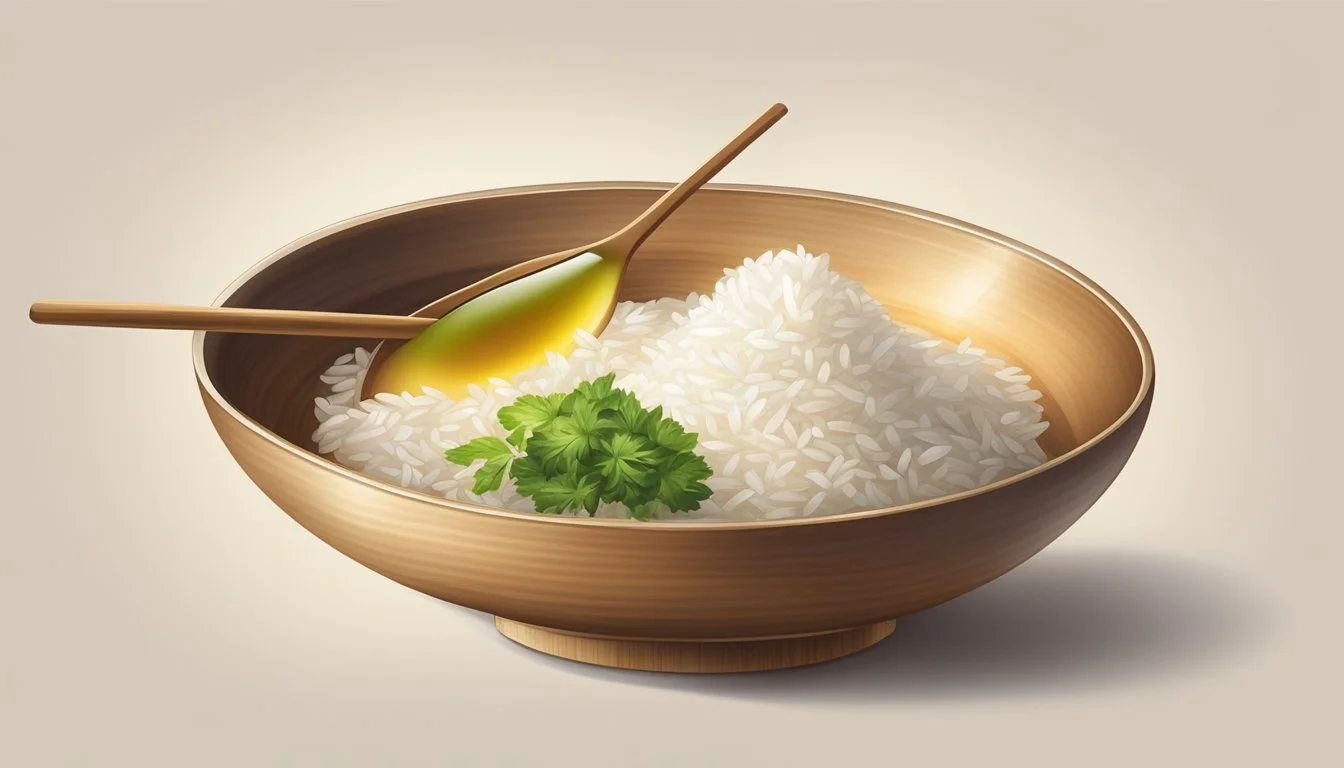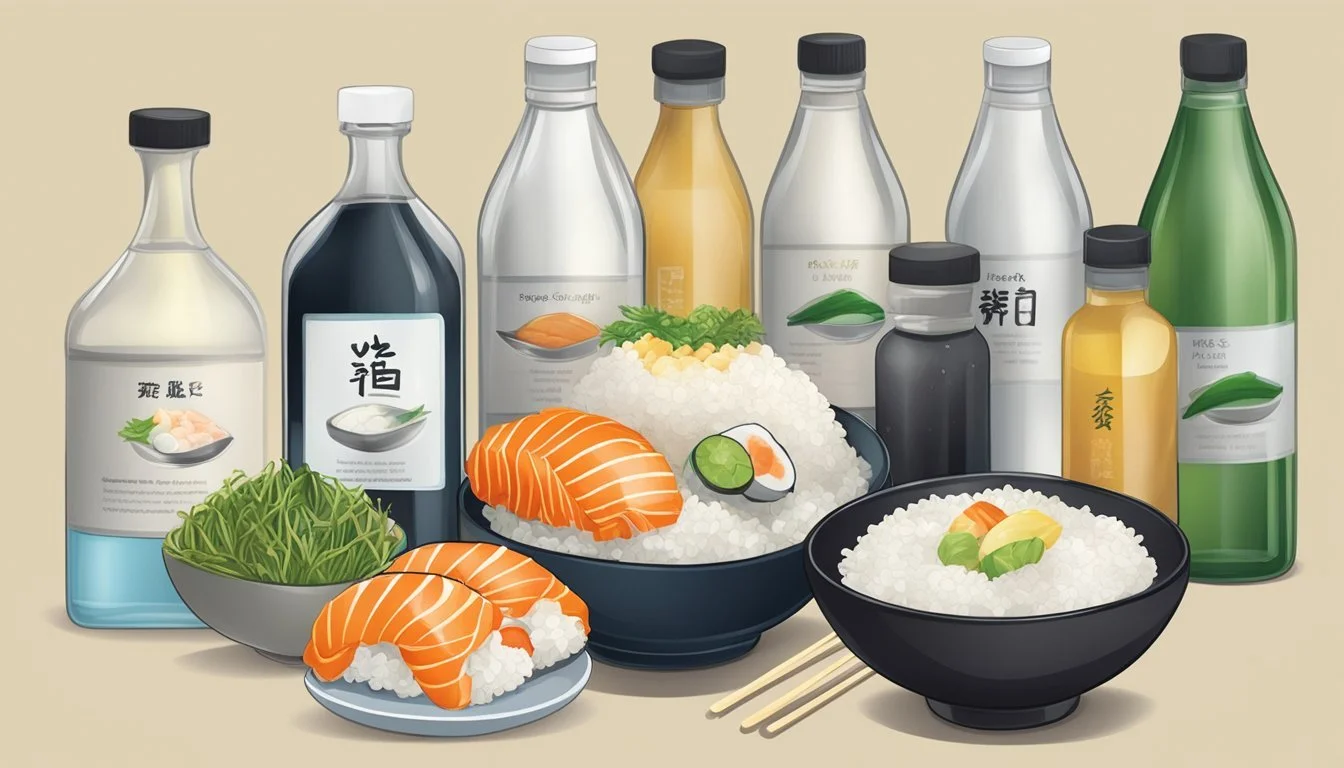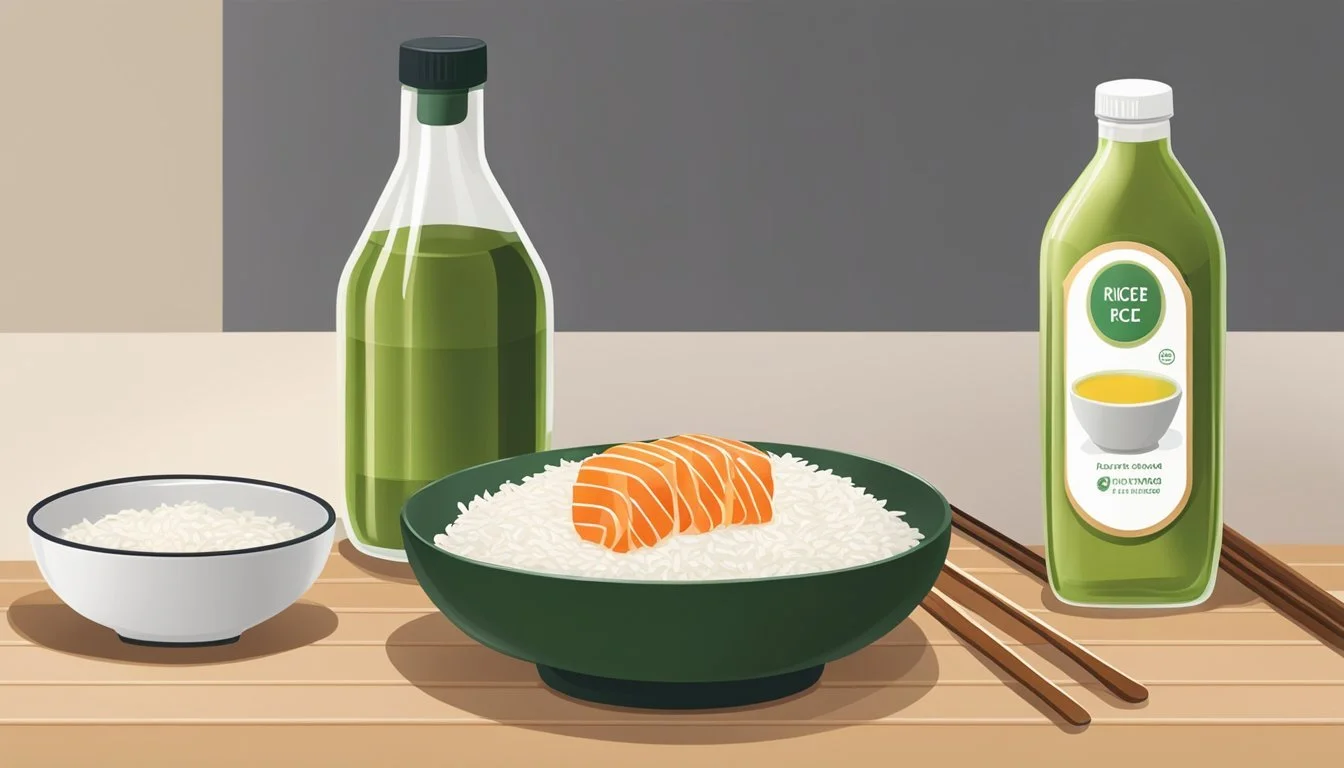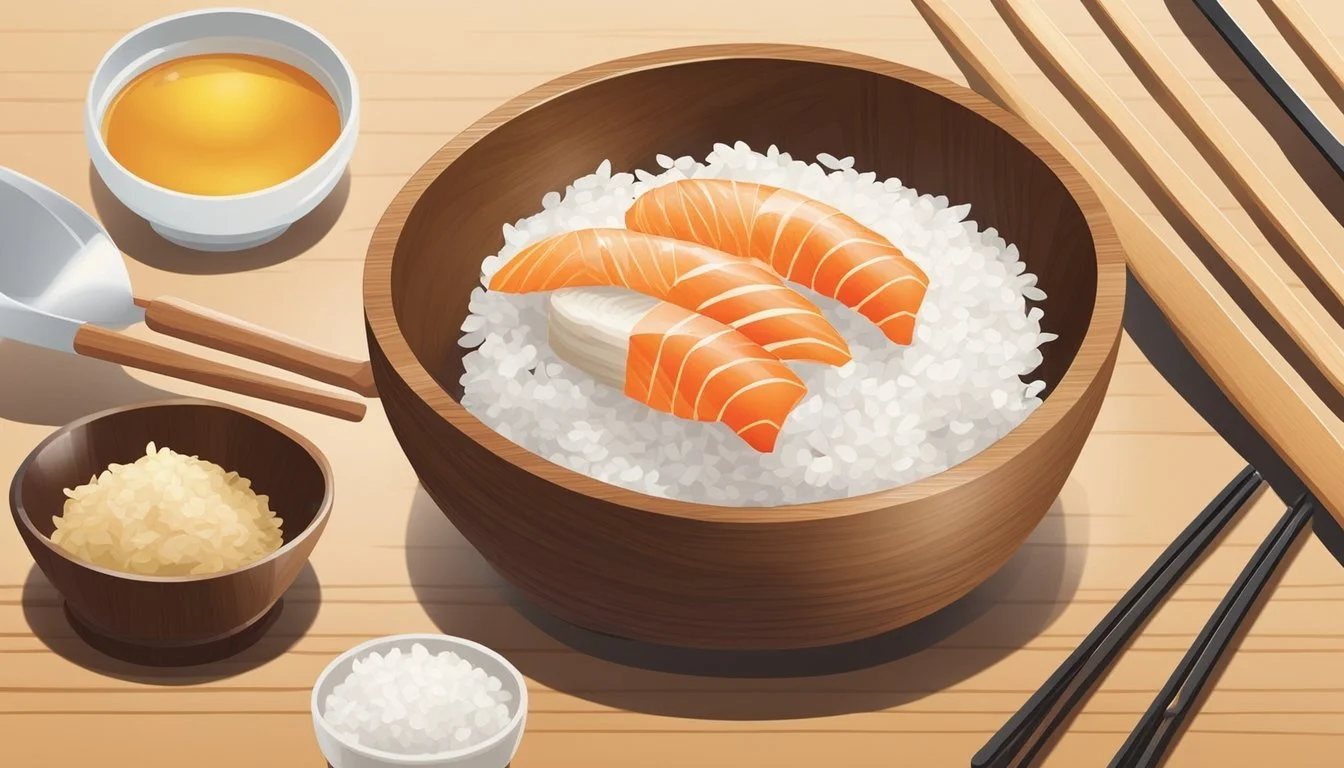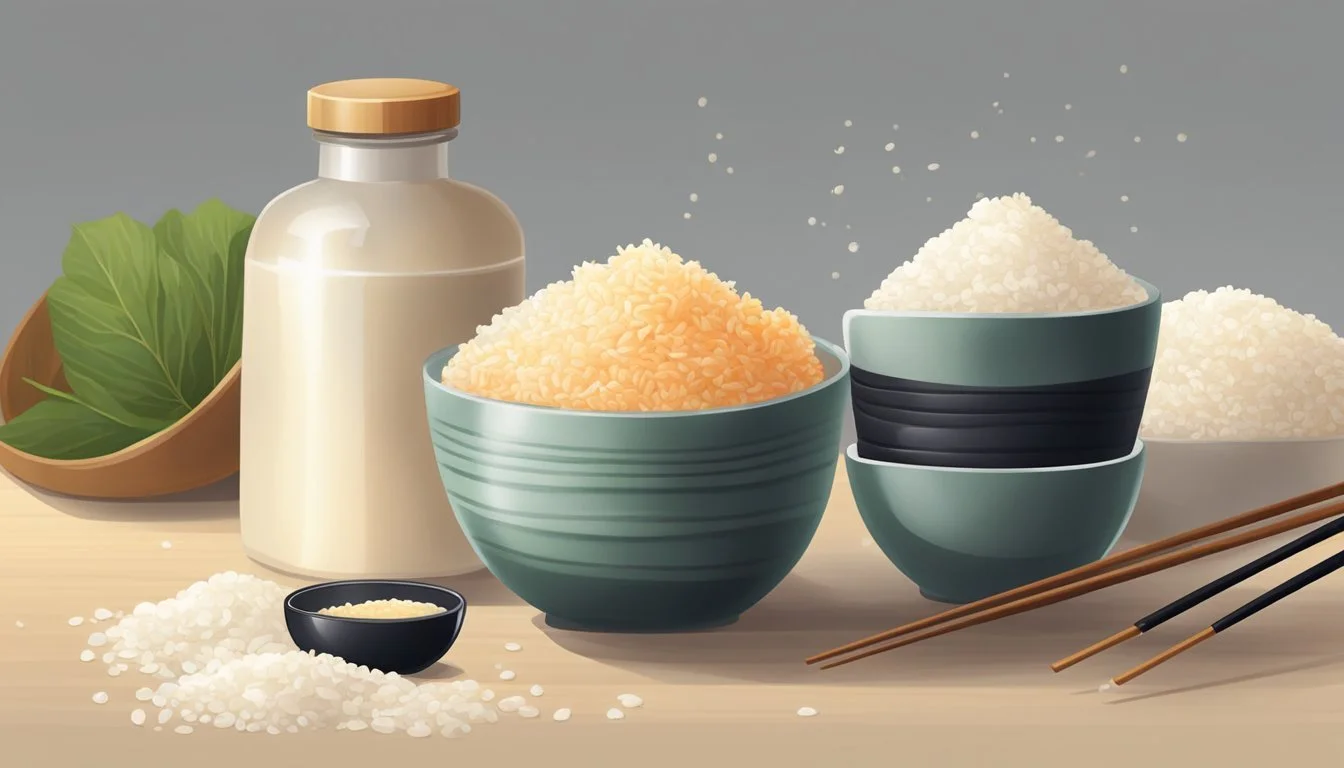How to Substitute Rice Vinegar for White Vinegar in Sushi Rice
A Simple Swap Guide
Crafting the perfect sushi (What wine goes well with sushi?) rice (What wine goes well with rice?) is a cornerstone of Japanese cuisine, where the subtle balance of flavors is crucial. Rice vinegar is traditionally used for seasoning sushi rice, infusing it with a mild acidity that enhances the taste without overpowering the delicate flavor of the fish. However, when rice vinegar is not available, white vinegar can be an effective substitute. White vinegar, with a stronger acidity, can be tempered to mimic the softer taste of rice vinegar with a few adjustments.
When substituting white vinegar for rice vinegar in sushi rice, it's important to dilute the white vinegar or adjust the quantity to avoid an overly acidic flavor profile. The sushi rice's texture and the final dish's harmony rely on the careful integration of the vinegar solution. Chefs and home cooks may make use of white vinegar by either reducing its intensity or blending it with other ingredients to achieve a flavor akin to that of traditional rice vinegar. The key is to retain the sushi rice's stickiness and sweetness while introducing the necessary tang that rice vinegar typically provides.
Understanding Rice Vinegar and Its Role in Sushi Rice
Rice Vinegar is integral to creating the authentic flavor and texture of sushi rice, providing a distinct combination of sweetness and acidity that is essential to Japanese cuisine.
The Basics of Sushi Rice Seasoning
Sushi rice seasoning, known as sushi vinegar or sushi-zu, typically comprises rice vinegar, sugar, and salt. This mixture is folded into the cooked rice (how long does cooked rice last?), imparting a balance of flavors that is a hallmark of authentic sushi. The seasoning's components contribute the following:
Rice vinegar: Adds a gentle acidity
Sugar: Brings mild sweetness
Salt: Imparts a subtle savory note
These ingredients are mixed and then cooled before being added to the sushi rice. The proper application of sushi vinegar ensures the rice has the correct flavor and stickiness that sushi requires.
Characteristics and Benefits of Rice Vinegar
Rice vinegar is milder and less acidic than other vinegars and has a subtle sweetness. These characteristics are vital for sushi rice, as they influence the final product in several ways:
Flavor: Rice vinegar's mild acidity enhances the inherent taste of the rice without overwhelming it.
Texture: The proper use of rice vinegar creates the ideal stickiness conducive to the formation of sushi.
Authenticity: It provides the traditional Japanese profile authentic to sushi found in Japanese cuisine.
Benefits:
Gentle on the Palate: Its subdued nature is less likely to overpower delicate fish flavors.
Complements the Filling: Rice vinegar stands as a backdrop, allowing the taste of the sushi fillings to prevail.
White Vinegar as a Substitute
When substituting white vinegar for rice vinegar in sushi rice, understanding the differences in flavor profile and acidity is crucial to achieving the desired taste and balance.
Flavor Profile Differences
Rice vinegar, traditionally used in sushi rice, is milder and slightly sweet compared to the sharper and more potent white vinegar. The flavor of white vinegar is more pronounced, so it may slightly alter the taste of sushi rice. When using white vinegar as a substitute, one should be aware of the contrasting flavor intensity.
Adjusting Acidity and Sweetness
To adjust for the sharper acidity of white vinegar, one can dilute it with water to more closely match the gentle tang of rice vinegar. Here's a simple guideline to follow:
Rice Vinegar: 1 tablespoon
White Vinegar Substitute: 1 tablespoon white vinegar + 1 tablespoon water
Additionally, to compensate for the lack of sweetness in white vinegar, adding a small amount of sugar can be beneficial. A pinch or two, depending on taste, should suffice. Here's a proportional suggestion:
Add 1/4 teaspoon of sugar for every tablespoon of white vinegar to approximate the sweetness of rice vinegar.
By making these adjustments, white vinegar can serve as a suitable substitute for rice vinegar in sushi rice, ensuring that the sushi rice maintains its signature flavor profile.
The Importance of Balance
In the preparation of sushi rice, maintaining a balance of flavor is crucial when substituting rice vinegar with white vinegar. The sushi rice recipe depends on a delicate mix of sweetness, acidity, and saltiness to achieve the characteristic taste.
Mixing the Right Proportions
When substituting white vinegar for rice vinegar, one needs to compensate for the milder and slightly sweeter profile of rice vinegar. Typically, rice vinegar is less acidic than white vinegar, so balance is attained by adjusting the sugar and salt levels. The addition of sugar lessens the harshness of white vinegar, while salt complements the tanginess.
Substitute Ratios
For a standard sushi rice recipe, the substitute ratio to achieve similar acidity levels is a 1:1 ratio of white vinegar to rice vinegar. Since white vinegar is stronger, the recipe may call for slightly less vinegar overall or a touch more sugar. One may consider adding 1/4 teaspoon of sugar per tablespoon of white vinegar to closely mimic the intended flavor.
Sensory Considerations
The sensory balance in sushi rice encompasses taste, smell, and mouthfeel. Substitutes should not overpower the natural subtle flavors of the rice and other ingredients. Tasters should look for the right level of acidity that does not overwhelm the palate or alter the fragrance of the dish. They should adjust the amount of vinegar and seasonings cautiously and taste as they go to ensure the desired sensory balance is reached.
Alternative Vinegar Varieties
When substituting rice vinegar for sushi rice, other varieties of vinegar can be used to maintain the balance of sweetness and acidity essential for the dish's flavor profile.
Apple Cider Vinegar
Apple cider vinegar, produced from fermented apple juice, provides a fruity undertone that complements the tanginess similar to rice vinegar. It's a versatile substitute that should be used in a 1:1 ratio with rice vinegar.
Flavor Profile: Mildly sweet and fruity
Substitution Ratio: 1:1 with rice vinegar
White Wine Vinegar
White wine vinegar, with its mild taste and slight tanginess, is an excellent alternative to rice vinegar, particularly for sushi rice. For each tablespoon of rice vinegar, one can use the same amount of white wine vinegar to achieve the delicate balance required for sushi rice.
Flavor Profile: Mild and lightly tangy
Substitution Ratio: 1:1 with rice vinegar
Red Wine Vinegar and Others
Red wine vinegar, although more robust than rice vinegar, can be used cautiously as a substitute. To best replicate the desired taste in sushi rice, it may be necessary to dilute the red wine vinegar with water. Other vinegars, such as champagne vinegar or seasoned vinegars, could also substitute for rice vinegar but always check for compatibility with the sushi's flavor.
Flavor Profile: Robust and rich
Substitution Ratio: Dilution advised; start with less and adjust to taste
Note: The profile of each vinegar varies, and taste adjustments may be necessary when substituting for rice vinegar to ensure the sushi rice retains its characteristic flavor.
Non-Vinegar Substitutes
When looking for non-vinegar substitutes for sushi rice, one should consider the balance of acidity and sweetness that rice vinegar provides. Citrus juices can be an excellent alternative, offering a similar zesty flavor. Some chefs also explore other replacements that mimic the essence of the traditional sushi rice taste.
Citrus Juices as Alternatives
Lemon Juice: A common substitute for rice vinegar in sushi rice is lemon juice. It should be used sparingly due to its strong flavor, with a recommended ratio of half a teaspoon of lemon juice to one tablespoon of rice vinegar. Adding a sweetener can help balance the tartness.
Lime Juice: Lime juice serves as another viable replacement, especially in Thai-inspired sushi, due to its prominent role in the cuisine. For every tablespoon of rice vinegar, use an equal amount of lime juice, but one might need to adjust the quantity based on personal taste preferences and the sweetness of the lime.
Other Creative Replacements
Mirin: While not a citrus-based substitute, mirin is a sweet rice wine that can subtly mimic the sweetness of rice vinegar when sweetness is more desired than acidity. A blend of mirin with a touch of a tart component, such as lemon or lime juice, could replicate the intended flavor profile.
Sake and Sweetener: In the absence of mirin, sake paired with a sweetener offers a similar effect. Sake provides a depth of flavor while a suitable sweetener, like sugar or honey, would contribute the necessary sweetness. Use sake in moderation as its alcohol content may alter the final taste if used excessively.
Preparing Sushi Rice with Vinegar Substitutes
Creating sushi rice with a vinegar substitute, such as white vinegar, requires understanding the correct proportions and techniques to maintain the rice’s desired stickiness and flavor. Below is a detailed process to achieve that perfect stickiness with white vinegar as a substitute for the traditional rice vinegar.
Step-by-Step Guide Using White Vinegar
Measure and rinse 1 cup of short-grain sushi rice under cold water until the water runs clear to remove excess starch.
Cook the rice according to the package directions or use a 1:1.2 rice-to-water ratio and simmer until the water is absorbed.
Heat a mixture of 3 tablespoons white vinegar, 1 tablespoon sugar, and 1/2 teaspoon salt just until the sugar dissolves.
Transfer the cooked rice to a large bowl, preferably made of wood for traditional results, and gently fold the vinegar mixture into the rice with a paddle or spatula.
Fan the rice for a few minutes as you mix to quickly reduce the rice's temperature to slightly above room temperature and help achieve the right texture.
Tips for Achieving Perfect Stickiness
Use a rice type that is inherently sticky when cooked, such as Japanese short-grain rice or similar varieties.
Avoid vigorous stirring or mashing; gently folding the rice helps maintain the grains' integrity and the correct stickiness level.
Consistency is key, so always use the same type of rice and adjust the amount of vinegar mixture based on the rice batch size.
Temperature Considerations
Perfect sushi rice should be body temperature when assembling sushi, which is why cooling the rice efficiently is crucial.
If the rice is too hot, it becomes overly sticky and difficult to work with, while too cold rice will be too firm and lose its stickiness.
Allowing the rice to cool to just the right temperature, which is slightly above room temperature, involves balancing between cooling it quickly while folding and letting it rest before use.
Enhancing Sushi Flavor Beyond Vinegar
While rice vinegar lays the foundation for sushi's tangy taste, the culinary journey doesn’t end there. Expert sushi chefs employ a range of seasonings to elevate the dish's flavor profile and harmonize with the delicate textures of fish and other toppings.
Complementary Seasoning for Sushi Rice
Creating an impactful sushi rice flavor extends beyond the tang of vinegar. Key seasonings to consider include:
Sugar and Salt: A balanced blend of sweetness and salinity enhances the rice's natural flavor without overpowering it. Normally, one would use a mixture of two tablespoons of sugar and one tablespoon of salt for every cup of rice vinegar.
Kombu: This seaweed imparts a subtle umami punch. A piece of kombu can be simmered with the rice and removed before dressing the rice, leaving behind its distinct savory note.
Sesame Seeds: Toasted black or white sesame seeds can be sprinkled on top of the sushi rice for a nutty crunch.
Wasabi: While typically served as a condiment, a small amount mixed directly into the rice can intensify the sushi's overall flavor.
A well-seasoned sushi rice forms a solid yet unobtrusive base that complements the various flavors of sushi rolls.
Pairing with Fish and Other Toppings
The sushi experience is as much about the integrity of individual ingredients as it is about the synergy between them. Each component should be chosen to highlight the fish and toppings:
Fish: Freshness is paramount, and milder seasoning on the rice allows the fish's natural flavor to shine. Oily fish like salmon or tuna pairs well with the added zest of seasoned rice.
Nori: The toasted seaweed wrapping, nori, contributes its own oceanic taste. A mild rice seasoning ensures nori’s presence is felt without dominating the palate.
Additional Toppings: With toppings like avocado, cucumber, or pickled radish, it's important the seasoned rice doesn’t overshadow these delicate flavors but enhances their fresh and crunchy textures.
Through meticulous seasoning of sushi rice and thoughtful pairing with fish and other toppings, one can create a sushi experience that resonates with depth and harmony.
Serving and Storage Tips
When substituting white vinegar for rice vinegar in sushi rice, it's important to maintain the quality and taste of the rice. This relies on proper serving and preservation methods to ensure freshness.
Best Practices for Serving Substituted Sushi Rice
To ensure optimal taste and texture, sushi rice should be served shortly after it's prepared. The sushi rice vinegar substitution does not affect the serving temperature, which should be at body temperature for the best experience. It is crucial to mix the vinegar blend gently into the cooked rice to avoid breaking the grains, which could result in a mushy texture not suitable for sushi.
Preservation and Longevity
Preservation plays a crucial role in maintaining the freshness of sushi rice. If the rice must be stored, it should be covered with a damp cloth and kept at room temperature for no more than a few hours. For longer storage, sushi rice can be refrigerated for up to 24 hours. This rice often does not contain preservatives, so refrigeration is essential to slowing down spoilage. However, the rice will harden when cold, so it should be brought back to room temperature before serving to regain its desired texture.
Health Considerations and Benefits
When considering the substitution of rice vinegar for white vinegar in sushi rice, one should be aware of the health benefits each vinegar may carry.
Nutritional Profiles of Different Vinegars
Rice vinegar is typically milder in flavor and less acidic than white vinegar. In terms of nutrition, rice vinegar offers a small amount of nutrients such as potassium, which can be beneficial for maintaining electrolyte balance, and magnesium, which supports muscle and nerve function. It also contains traces of calcium for bone health. Rice vinegar tends to be gluten-free, making it suitable for those with gluten sensitivities or celiac disease.
On the other hand, white vinegar may lack these additional nutrients but can still be part of a healthy diet in moderation. Since it is more acidic, white vinegar is often used in smaller quantities, which may reduce its overall health impact when compared to rice vinegar, if used.
Both vinegars are low in caloric content, and neither provides a significant amount of vitamins. As such, their contribution to nutritional intake is minimal but can still be a part of a well-balanced diet that focuses on digestive health. Inclusion in recipes like sushi rice is more about flavor enhancement rather than providing health benefits. However, the fermentation process that produces both vinegars can contribute to digestive health by introducing beneficial bacteria that support a healthy gut microbiome.
In summary, while both types of vinegar may share certain health benefits like promoting digestive health, rice vinegar contains additional nutrients beneficial to overall well-being and is a staple in many Asian cuisines. It is a healthy option for those looking for a less acidic ingredient in their sushi rice while also catering to a gluten-free dietary requirement.



